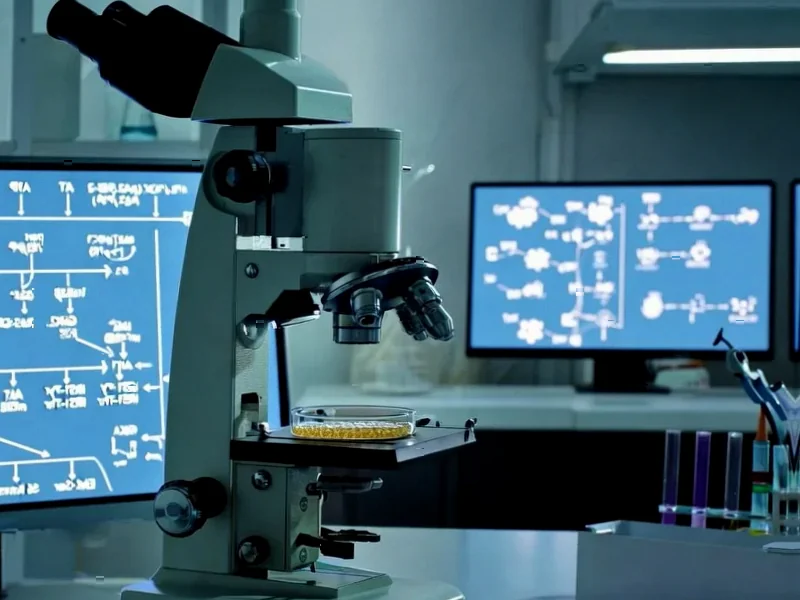According to Nature, researchers have developed RECKLEEN, a single-plasmid platform that combines lambda Red recombination with CRISPR-Cas9 for enhanced genome editing in Klebsiella pneumoniae. The system achieved remarkable killing efficiencies up to 99.977% when optimized with weaker promoters for anti-CRISPR protein expression, and demonstrated editing efficiencies of 91.7% using double-stranded donor DNA with 500bp homology arms. The platform overcame initial toxicity issues through strategic implementation of anti-CRISPR protein AcrIIA4, which prevented unintended cell death from basal Cas9/sgRNA expression. This breakthrough enables efficient genetic manipulation of a pathogen that has been notoriously difficult to engineer.
Table of Contents
The Klebsiella Engineering Problem
Klebsiella pneumoniae represents one of the most challenging bacterial systems for genetic manipulation due to its complex capsule structure and intrinsic resistance mechanisms. Traditional genetic tools often fail in this organism because of its robust DNA repair systems and protective outer membrane. The difficulty in engineering K. pneumoniae has significantly hampered research into its virulence factors and antibiotic resistance mechanisms, despite its status as a priority pathogen for drug development. RECKLEEN’s success in achieving high-efficiency editing addresses a critical bottleneck that has persisted for decades in bacterial genetics research.
Engineering Breakthroughs Behind the Platform
The RECKLEEN system’s success stems from several sophisticated engineering choices that previous attempts lacked. The integration of both lambda Red components and CRISPR-Cas9 on a single plasmid eliminates compatibility issues that plague multi-plasmid systems. More importantly, the careful balancing of anti-CRISPR protein expression represents a masterclass in synthetic biology regulation. By using progressively weaker constitutive promoters for AcrIIA4 expression, researchers essentially created a molecular buffer system that prevents toxicity while maintaining lethal efficiency when needed. This fine-tuning of component expression levels demonstrates how modern synthetic biology moves beyond simple gene insertion to precise control of genetic circuits.
Beyond Basic Gene Editing
The RECKLEEN platform’s implications extend far beyond simple gene deletions. The ability to efficiently introduce point mutations and DNA integrations using engineered Cas9 variants like SpG Cas9 opens possibilities for studying antibiotic resistance mechanisms at single-nucleotide resolution. This is particularly valuable for understanding how transcriptional regulation changes contribute to resistance development. The system’s compatibility with single-stranded oligonucleotides also enables rapid screening of mutation libraries, potentially accelerating the study of K. pneumoniae evolution in clinical settings.
Translational Research Applications
From a practical standpoint, RECKLEEN’s recyclable plasmid system represents significant cost and time savings for research laboratories. The ability to cure cells of the editing machinery means researchers can perform sequential genetic modifications without accumulating multiple antibiotic resistance markers. This is crucial for studying complex traits that involve multiple genes, such as capsule biosynthesis or siderophore production. The system’s high efficiency with short homology arms (100bp) and single-stranded DNA also reduces the time and resources needed for construct preparation, making sophisticated genetic studies more accessible to smaller research groups.
Scaling and Commercial Potential
While RECKLEEN represents a major advance, several challenges remain for widespread adoption. The system’s dependence on specific origins of replication and antibiotic selection may limit its utility across diverse K. pneumoniae clinical isolates. Future iterations will need to address plasmid stability in non-laboratory strains and potentially incorporate temperature-sensitive replication for easier curing. From a commercial perspective, this technology could revolutionize antibiotic discovery pipelines by enabling systematic study of resistance mechanisms, but will require validation across broader strain collections before pharmaceutical companies can confidently integrate it into their development workflows.
Implications for Bacterial Genetics
RECKLEEN’s success suggests that similar approaches could be adapted for other difficult-to-manipulate bacterial pathogens. The fundamental insight—that careful balancing of Cas9 activity through anti-CRISPR buffering can overcome toxicity issues—may apply to numerous bacterial systems where CRISPR tools have underperformed. As researchers continue to refine the understanding of PAM requirements and Cas9 variant specificity, platforms like RECKLEEN will become increasingly sophisticated, potentially enabling routine genetic manipulation of even the most recalcitrant bacterial pathogens within the next five years.



